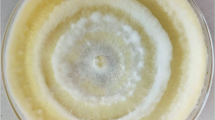Abstract
The effect of the composition, consistence and pH of the media was investigated in 57 species (110 strains) of gill fungi of theAgaricaeae family with respect to the influence of cultivation conditions. The results showed that different genera have diverse nutritional requirements. Wort agar, adjusted to pH 5.5 was suitable for most of the fungi investigated. The growth rate of mycelial colonies was also compared, and the effect of the fungi on the cultivation medium and certain manifestations associated with growth, including fructification. A growth coefficient, expressing the relation of the length, height and density of the aerial mycelium after 14 days of cultivation was used to characterize the manner of growth of the different species. The experiments confirmed that most wood-inhabiting species grow rapidly, terrestrial fungi more slowly, and mycorrhizal fungi the slowest. Strains of the same species preserved similar growth characteristics. Microscopic study of the growth of the aerial mycelium revealed clamp connections in the hyphae in 69% of the fungi investigated and secondary spores in 11%.
Similar content being viewed by others
References
Aschan, K.:The production of fruit-bodies in Collybia velutipes. Physiol. Plant. 7: 571, 1954.
Benton, V. L., Ehrlich, J.:Variations in culture of several isolates of Armillaria mellea from western white pine. Phytopathology 31: 803, 1941.
Borris, H.:Beiträge zur Wachstums-und Entwicklungsphysiologie der Fruchtkörper von Coprinus lagopus. Planta 22: 28, 1934.
Cartwright, T. S. G., Findlay, W. P. T.:Decay of timber and its prevention, p. 293 Ed. His Majesty’s Stationary Office, London 1946.
Fries, N.:Über die Bedeutung von Wuchsstoffen für das Wachstum verschiedener Pilze. Symb. bot. upsal. III. 2: 1, 1938.
Garrett, S.D.:Function of the mycelial strands in substrate colonisation by the cultivated mushroom, Psalliota hortensis. Trans. brit. mycol. Soc. 37: 51, 1954.
Gibson, I. A. S.:A note of variation between isolates of Armillaria mellea (Vahl. ex Fr.) Kummer. Trans. Brit. mycol. Soc. 44: 123, 1961.
Hamada, M.:Physiologisch morphologische Studien über Armillaria mellea (Vahl.) Quél., mit besonderer Rücksicht auf die Oxalsäurebildung. Jap. J. Bot, 10: 387, 1940.
Handke, H. H.:Zur Fruchtkörperbildung holzbewohnender Basidiomyceten in Kultur. Holzzerstörung durch Pilze, Intern. Symp. Eberswalde, p. 43, 1962.
Hein, J.:Studies in the mycelium of Psalliota campestris. Am. J. Botany 17: 197, 1930.
Hübsch, P.:Die Beeinflussung des Myzelwachstums von Beinkulturen von Boletazeen durch Kartoffelextrakte. Mykorrhiza, Intern. Myk. Symp. Weimar 1960, p. 101, 1963.
Koch, W.:Untersuchungen über Myzelwachstum und Fruchtkörperbildung bei einigen Basidiomyceten. Arch. Mikrobiol. 30: 409, 1958.
Lindeberg, G.:Über das Wuchsstoffbedürfnis verschiedener Arten der Pilzgattung Marasmius. Svensk. bot. Tidskr. 33: 341, 1939a.
Lindeberg, G.:Über den Einfluss der Wasserstoffionenkonzentration auf das Wachstum verschiedener Marasmius-Arten. Svensk. bot. Tidskr. 33: 341, 1939b.
Lohwag, K.:Zur Fruchtkörperbildung holzzerstörender Pilze in Reinkultur, Sydowia, 6: 323, 1952.
Marczynski, R.:Studies in the nutrition of Collybia velutipes (Curt.) Quél. Amer. Mid. Nat. 30: 164, 1943.
Mathew, K. T.:Morphogenesis of mycelial strands in the cultivated mushroom Agaricus bisporus. Brit. mycol. Soc. 44: 285, 1961.
Melin, E.:Der Einfluss von Waldstreuextrakten auf das Wachstum von Bodenpilzen mit besonderer Berücksichtigung der Wurzelpilze von Bäumen, Symb. bot. upsal. VIII. 3: 1, 1946.
Modess, O.:Zur Kenntniss der Mykorrhizabildner von Kiefer und Fichte. Symb. bot. upsal. V. I: 1, 1941.
Niederpruem, D. J.:Role of CO 2 in the control of fruiting of Schizophyllum commune. J. Bacteriol. 85: 1300, 1963.
Norkrans, B.:The effect of glutamin acid, aspartic acid, and related compounds on the growth of certain Tricholoma species. Physiol. Plant. 6: 584 1953.
Nobles, M.:Studies of forest pathology. IV. Identification of cultures of wood-rotting fungi. Canad. J. Re. 26C: 281, 1948.
Oddoux, L.:Essai de culture de 508 especes d’homobasidiomycetes. Mushroom Science 2: 28, 1953.
Plunkett, B. E.:Nutritional and other aspects of fruit-body production in pure cultures of Collybia velutipes (Curt.) Fr. Ann. Bot. London, 17: 193, 1953.
Plunkett, B. E.:The influence of factors of the aeration complex and light upon fruit-body in pure cultures of an Agaric and a Polypore. Ann. Bot. London, 20: 563, 1956.
Raper, J. R., Krongelb, G. S.:Genetic and enrironmental aspects of fruiting in Schizophyllum commune Fr. Mycologia 5: 707, 1958.
Rawald, W.:Zur Fruchtkörperbildung höherer Pilze in künstlicher Kultur. Z. Pilzkde. 27, Sonderheft 2-4: 83, 1962a.
Rawald, W.:Zur Abhängigkeit des Myzelwachstums höherer Pilze von der Versorgung mit Kohlenhydraten. Z. allgem. Mikrobiol. 2: 303, 1962b.
Rawald, W.:Untersuchungen zur Stickstoffernährung der höheren Pilze. Mykorrhiza, Intern. Myk. Symp-Weimar 1960, p. 66, 1963a.
Rawald, W.:Über extrazelluläre Wirkungen höherer Pilze. Mykorrhiza. Intern. Myk. Symp. Weimar 1960, p. 241, 1963b.
Rawald, W.:Beiträge zur künstlichen Kultur höherer Pilze. Z. Allgem. Mikrobiol. 3: 54, 1963c.
Rawald, W.:Das Myzelwachstum höherer Pilze in seinen Beziehungen zu natürlichen Substraten und deren Extrakten. Arch. Forstwes. 12: 483, 1963d.
Robbing, W. J., Hervey, A.:Wood, tomato and malt extracts and growth of some basidiomycetes. Mycologia 5: 745, 1958.
Rypáček, V.:Biology of wood-destroying fungi. (In Czech) p. 209 Publ. House Czechoslov. Acad. Sci., Prague 1957.
Semerdzieva, M.:Kultivierungen und morphologische Untersuchungen einiger Pilze der Familie Agaricaceae in vitro. (In Czech) Čs. mykologie 19: 230, 1965.
Singer, R.:The Agaricales in modern taxonomy. p. 900 2. Ed. Belser, Stuttgart, 1962.
Snider, P. J.:Stages of development in rhizomorphic thalli of Armillaria mellea. Mycologia 51: 693, 1959.
Townsend, B. B.:Morphology and development of fungal rhizomorphs. Brit. mycol. Soc. Trans. 37: 222, 1954.
Treschow, C.:Nutrition of the cultivated mushroom Dansk. bot. Ark. 11: 1, 1944.
Voznyakovskaya, J. M.:The problem of mycorrhiza and its practical significance. (In Russian). Mikrobiologiya 23: 204, 1954.
Zycha, H.:Basidiomycetes, in Hassebrauk K.:Handbuch der Pflanzenkrankheiten, Band III, Lief. 4, p. 550 Ed. Parey, Berlin, 1962.
Author information
Authors and Affiliations
Rights and permissions
About this article
Cite this article
Semerdzieva, M., Cejp, K. Investigation of mycelial growth in some gill fungi under laboratory conditions. Folia Microbiol 11, 146–154 (1966). https://doi.org/10.1007/BF02878843
Received:
Issue Date:
DOI: https://doi.org/10.1007/BF02878843




